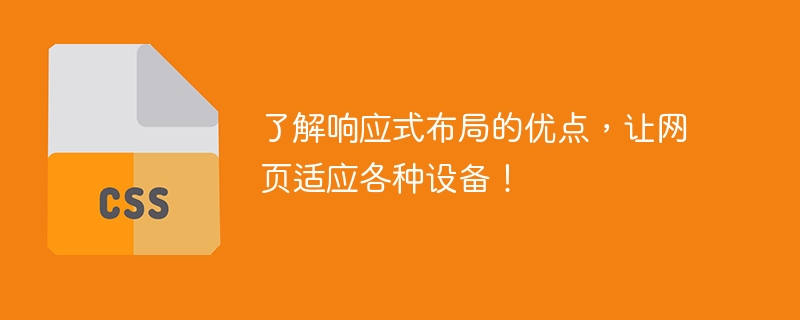Home >Web Front-end >CSS Tutorial >Master the benefits of responsive design and make your web pages adapt perfectly to different devices!
Master the benefits of responsive design and make your web pages adapt perfectly to different devices!
- WBOYWBOYWBOYWBOYWBOYWBOYWBOYWBOYWBOYWBOYWBOYWBOYWBOriginal
- 2024-02-19 12:25:081041browse

Understand the advantages of responsive layout and adapt web pages to various devices!
With the popularity and development of mobile Internet, more and more people are beginning to use mobile phones and tablets to access web pages. In this multi-device era, how to adapt web pages to different screen sizes and devices has become an important issue. Here, we’ll introduce a popular solution – responsive layout.
Responsive layout is a technology based on web design and development that can automatically adjust the layout and arrangement of elements of a web page according to the user's device and screen size. This means users can get the best browsing experience whether they are accessing the web on a desktop, laptop, tablet or mobile phone.
There are many advantages of responsive layout. First, it improves user experience. When a user accesses a webpage on a mobile phone, if the webpage does not have a responsive layout, the content of the page may be incompletely displayed on the screen, and the user needs to continuously scroll and zoom to view the entire content, which affects the user's browsing experience. With responsive layout, the web page will automatically adjust the layout according to the screen size, so that the page content can be fully displayed and users can browse the web more easily.
Secondly, responsive layout can reduce development and maintenance costs. In traditional web design, creating different versions of web pages for different devices requires a lot of time and energy. With responsive layout, you only need to design and develop a set of web pages to adapt to different devices, greatly reducing the workload. At the same time, when a web page needs to be updated or modified, only one set of web pages needs to be maintained, saving maintenance costs.
So how to implement responsive layout? Let's look at a specific code example.
<!DOCTYPE html>
<html>
<head>
<meta name="viewport" content="width=device-width, initial-scale=1.0">
<style>
body {
font-family: Arial, sans-serif;
margin: 0;
padding: 0;
}
.container {
max-width: 1200px;
margin: 0 auto;
padding: 20px;
}
.header {
text-align: center;
padding: 20px;
}
.menu {
background-color: #f2f2f2;
padding: 10px;
}
.content {
padding: 20px;
}
.footer {
text-align: center;
padding: 20px;
background-color: #f2f2f2;
}
@media (max-width: 768px) {
/* 在屏幕宽度小于768像素时,修改布局 */
.container {
padding: 10px;
}
.header,
.footer {
padding: 10px;
}
.menu {
padding: 5px;
}
}
</style>
</head>
<body>
<div class="container">
<div class="header">
<h1>响应式布局示例</h1>
</div>
<div class="menu">
<ul>
<li>首页</li>
<li>产品</li>
<li>关于我们</li>
</ul>
</div>
<div class="content">
<h2>欢迎访问我们的网页!</h2>
<p>这是一个响应式布局的示例网页。你可以尝试在不同的设备上访问,看看页面布局是否会随屏幕尺寸的变化而调整。</p>
</div>
<div class="footer">
© 2021 响应式布局示例网页
</div>
</div>
</body>
</html>In the above code, we use CSS’s @media query to implement responsive layout. When the screen width is less than 768 pixels, the style in the @media query will be applied. Here we have adjusted the padding of the container, the padding of the header and footer, and the padding of the menu to adapt to small screen devices.
By learning and understanding responsive layout, we can better provide users with an excellent browsing experience and reduce development and maintenance costs. Hopefully the code examples above will help you better understand and apply responsive layout.
The above is the detailed content of Master the benefits of responsive design and make your web pages adapt perfectly to different devices!. For more information, please follow other related articles on the PHP Chinese website!

